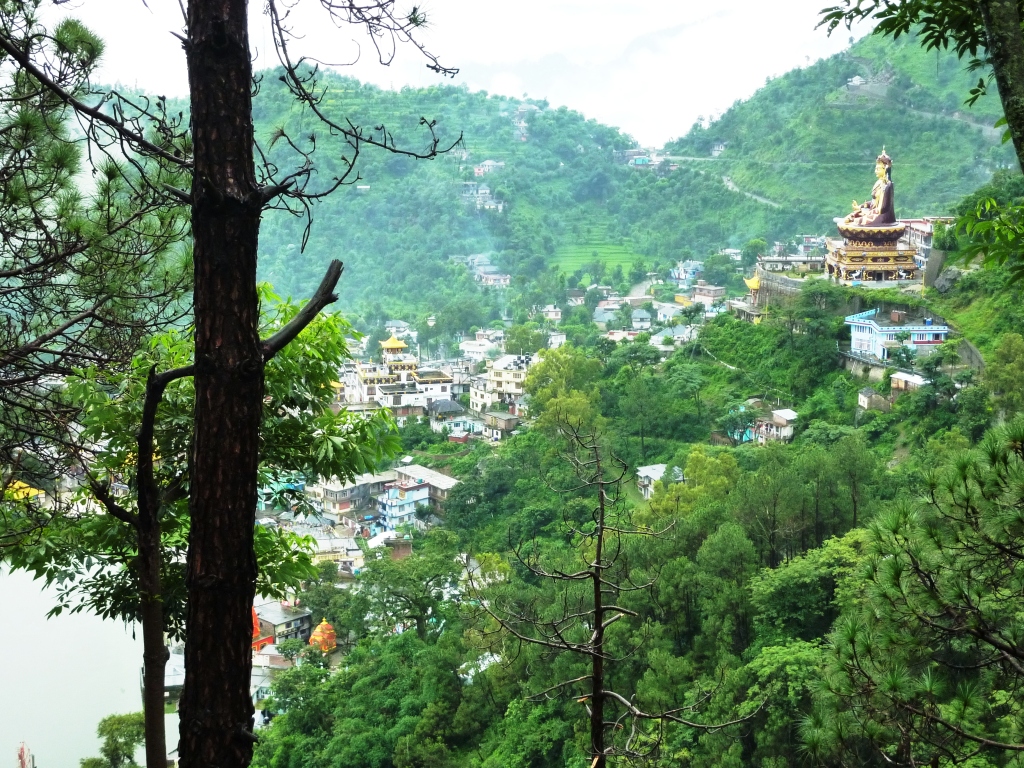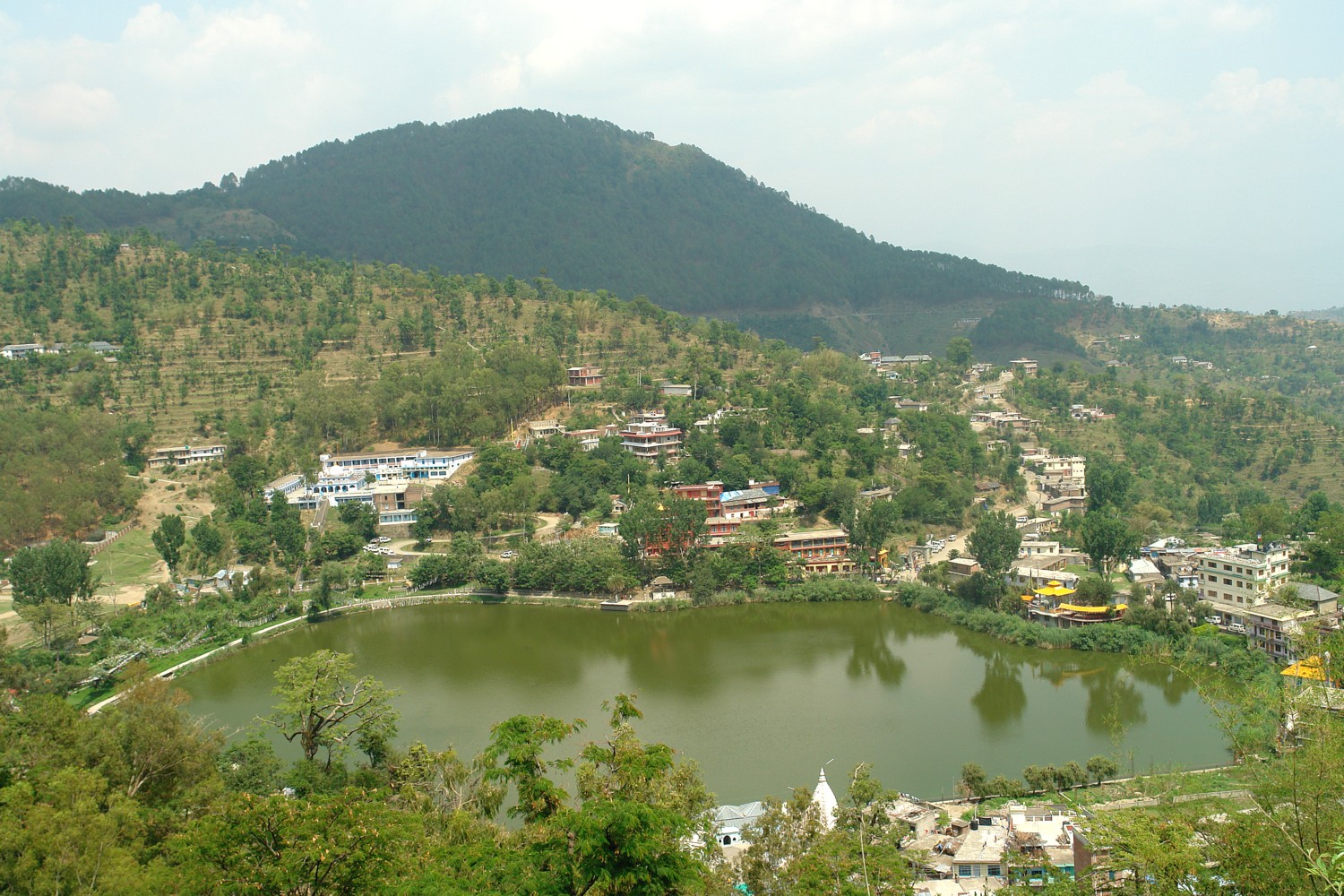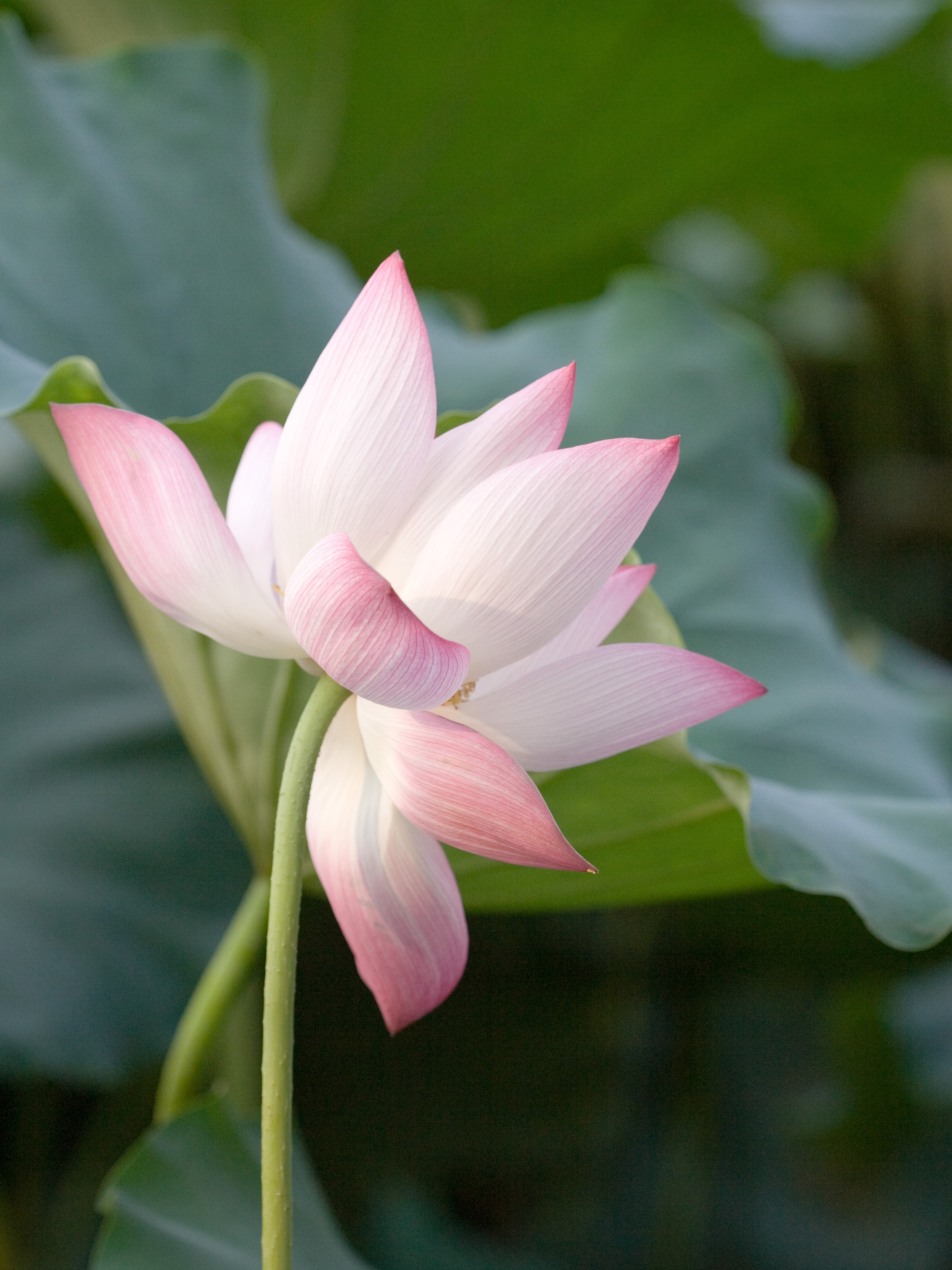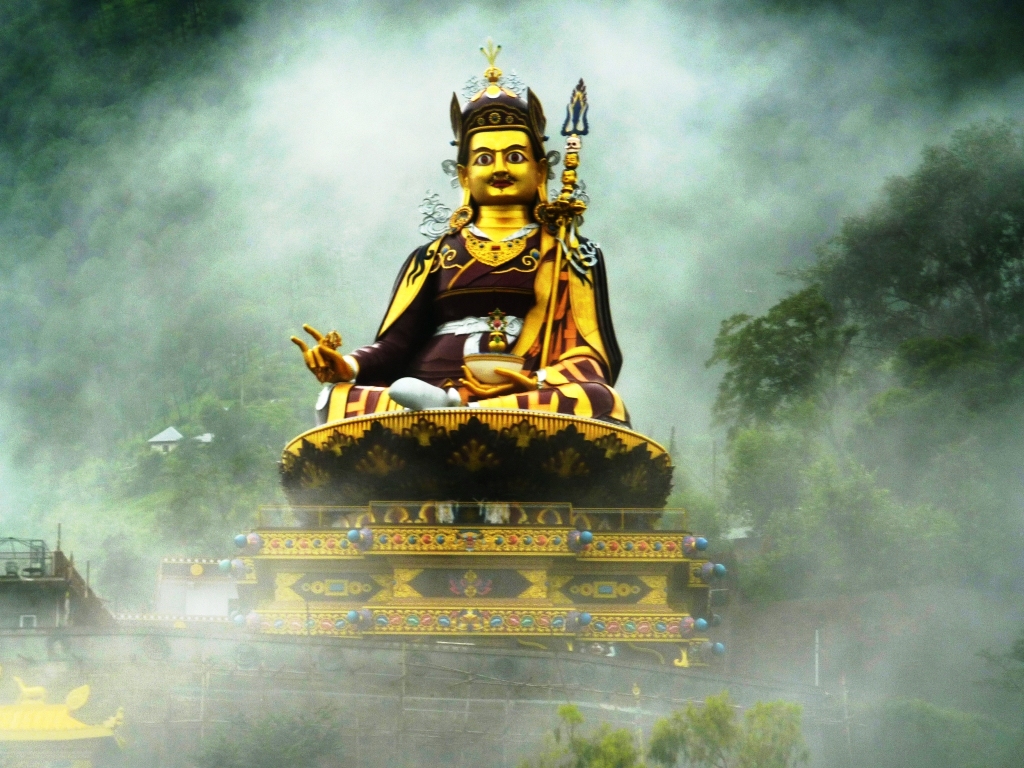|
Rewalsar Lake
Rewalsar Lake, also known as Tso Pema, is a mid-altitude lake located in the mountains of the Mandi district in Himachal Pradesh, India. It is located 22.5 km south-west from the town of Mandi, at an elevation of about above sea level, with a shoreline of about 735 m. Rewalsar Lake is a sacred spot for Hindus, Sikhs and Buddhists, and sacred to Tibetan Buddhists for the Vajrayana practices of Padmasambhava and Mandarava, which are credited for the lake's creation. There is a Colossus of Padmasambhava, a shrine to Mandarava, and three Buddhist monasteries at Rewalsar Lake. The Rewaksar Lake also has three Hindu temples, dedicated to Lord Krishna, Lord Shiva and to the sage Lomas. Another holy lake, Kunt Bhyog which is about above sea level lies above Rewalsar. It is associated with the escape of ' Pandavas' from the burning palace of wax—an episode from the epic '' Mahabharata''. After practicing with the local Relwasar king's daughter Mandarava, P ... [...More Info...] [...Related Items...] OR: [Wikipedia] [Google] [Baidu] |
Rewalsar, India
Rewalsar or Tso Pema in Tibetan is a small town and a pilgrimage place in a nagar panchayat in Mandi district in India. It is located in the state of Himachal Pradesh. The local name for Rewalsar is Tri Sangam. Rewalsar Lake is a tourist spot in the area. Demographics As of the 2001 India census, Rewalsar had a population of 1369. Males constitute 54% of the population and females 46%. Rewalsar has an average literacy rate of 76%, higher than the national average of 74.04%: male literacy is 78%, and female literacy is 73%. In Rewalsar, 12% of the population is under 6 years of age. Geography Rewalsar is located at an altitude of 1360 m above sea level. It is connected to Mandi by a motorable road and is about 25 km from Mandi. Lying in the Southern Himalayan belt, winters in Rewalsar can be freezing, while summers are generally pleasant. Religion Rewalsar is sacred to adherents of three major Dharma religions - Hinduism, Buddhism and Sikhism. Hinduism Seven lak ... [...More Info...] [...Related Items...] OR: [Wikipedia] [Google] [Baidu] |
Mandi District
Mandi district is one of the central districts of Himachal Pradesh state in northern India. The town of Mandi is the headquarters of the district. The main native language is Mandeali. As of 2011 it is the second most populous district of Himachal Pradesh (out of 12), after Kangra. Demographics According to the 2011 census Mandi district has a population of 999,777, roughly equal to the nation of Fiji or the US state of Montana. This gives it a ranking of 446th in India (out of a total of 640). The district has a population density of . Its population growth rate over the decade 2001-2011 was 10.89%. Mandi has a sex ratio of 1012 females for every 1000 males and a literacy rate of 82.81%. At the 2011 census, 59% of the population in the district identified their first language as Mandeali, 33% opted for Pahari (a term broadly applicable to most Indo-Aryan languages of Himachal and Uttarakhand), while 4.1% chose Hindi, 0.66% – Punjabi and 0.47% – Kangri. Subd ... [...More Info...] [...Related Items...] OR: [Wikipedia] [Google] [Baidu] |
Lomas (sage)
Lomas (Spanish for "hills"), also called fog oases and mist oases, are areas of fog-watered vegetation in the coastal desert of Peru and northern Chile. About 100 lomas near the Pacific Ocean are identified between 5°S and 30°S latitude, a north–south distance of about . Lomas range in size from a small vegetated area to more than and their flora includes many endemic species. Apart from river valleys and the lomas the coastal desert is almost without vegetation. Scholars have described individual lomas as "an island of vegetation in a virtual ocean of desert." In a nearly rainless desert, the lomas owe their existence to the moist dense fog and mist which rolls in from the Pacific. The fog is called garúa in Peru and Camanchaca in Chile. Environment According to the Köppen Climate Classification system, the coastal desert of Peru and the Atacama desert of Chile feature a rare desert climate, that is abbreviated "BWn" on climate maps with the n denoting freque ... [...More Info...] [...Related Items...] OR: [Wikipedia] [Google] [Baidu] |
Nelumbo Nucifera
''Nelumbo nucifera'', also known as sacred lotus, Laxmi lotus, Indian lotus, or simply lotus, is one of two extant species of aquatic plant in the family Nelumbonaceae. It is sometimes colloquially called a water lily, though this more often refers to members of the family Nymphaeaceae. Lotus plants are adapted to grow in the flood plains of slow-moving rivers and delta areas. Stands of lotus drop hundreds of thousands of seeds every year to the bottom of the pond. While some sprout immediately, and most are eaten by wildlife, the remaining seeds can remain dormant for an extensive period of time as the pond silts in and dries out. During flood conditions, sediments containing these seeds are broken open, and the dormant seeds rehydrate and begin a new lotus colony. Under favorable circumstances, the seeds of this aquatic perennial may remain viable for many years, with the oldest recorded lotus germination being from seeds 1,300 years old recovered from a dry lakebed in n ... [...More Info...] [...Related Items...] OR: [Wikipedia] [Google] [Baidu] |
Pyre
A pyre ( grc, πυρά; ''pyrá'', from , ''pyr'', "fire"), also known as a funeral pyre, is a structure, usually made of wood, for burning a body as part of a funeral rite or execution. As a form of cremation, a body is placed upon or under the pyre, which is then set on fire. In discussing ancient Greek religion Religious practices in ancient Greece encompassed a collection of beliefs, rituals, and mythology, in the form of both popular public religion and cult practices. The application of the modern concept of "religion" to ancient cultures has been ..., "pyre" (the normal Greek word for fire anglicized) is also used for the sacred fires at altars, on which parts of the animal sacrifice were burnt as an offering to the deity. Materials Pyres are crafted using wood. The composition of a pyre may be determined through use of charcoal analysis. Charcoal analysis helps to predict composition of the fuel and local forestry of the charcoal being studied. Ireland Specif ... [...More Info...] [...Related Items...] OR: [Wikipedia] [Google] [Baidu] |
Fire Sacrifice
Worship or deification of fire (also pyrodulia, pyrolatry or pyrolatria) is known from various religions. Fire has been an important part of human culture since the Lower Paleolithic. Religious or animist notions connected to fire are assumed to reach back to such early pre-''Homo sapiens'' times. Indo-European religions In Indo-European languages, there were two concepts regarding fire: that of an animate type called *''h₁n̥gʷnís'' (cf. Sanskrit ''agni'', English ''ignite'' from Latin ''ignis'', Polish ''ogień'' and Russian ''ogon''), and an inanimate type *''péh₂wr̥'' (cf. English ''fire'', Greek ''pyr'', Sanskrit ''pu''). A similar distinction existed for water. Archaeologically, evidence for Indo-Iranian fire worship and the rite of cremation is found at the transition from the Sintashta-Petrovka to the Andronovo culture around 1500 BC. Fire worship was prevalent in Vedic and the Ancient Iranian religion. Whereas cremation became ubiquitous in Hinduism, it was pr ... [...More Info...] [...Related Items...] OR: [Wikipedia] [Google] [Baidu] |
Apostasy
Apostasy (; grc-gre, ἀποστασία , 'a defection or revolt') is the formal disaffiliation from, abandonment of, or renunciation of a religion by a person. It can also be defined within the broader context of embracing an opinion that is contrary to one's previous religious beliefs. One who undertakes apostasy is known as an apostate. Undertaking apostasy is called apostatizing (or apostasizing – also spelled apostacizing). The term ''apostasy'' is used by sociologists to mean the renunciation ''and'' criticism of, or opposition to, a person's former religion, in a technical sense, with no pejorative connotation. Occasionally, the term is also used metaphorically to refer to the renunciation of a non-religious belief or cause, such as a political party, social movement, or sports team. Apostasy is generally not a self-definition: few former believers call themselves apostates due to the term's negative connotation. Many religious groups and some states punish apostat ... [...More Info...] [...Related Items...] OR: [Wikipedia] [Google] [Baidu] |
Guru Gobind Singh
Guru Gobind Singh (; 22 December 1666 – 7 October 1708), born Gobind Das or Gobind Rai the tenth Sikh Guru, a spiritual master, warrior, poet and philosopher. When his father, Guru Tegh Bahadur, was executed by Aurangzeb, Guru Gobind Singh was formally installed as the leader of the Sikhs at the age of nine, becoming the tenth and final human Sikh Guru. His four biological sons died during his lifetime – two in battle, two executed by the Mughal governor Wazir Khan.; Among his notable contributions to Sikhism are founding the '' Sikh'' warrior community called ''Khalsa'' in 1699 and introducing ''the Five Ks'', the five articles of faith that Khalsa Sikhs wear at all times. Guru Gobind Singh is credited with the ''Dasam Granth'' whose hymns are a sacred part of Sikh prayers and Khalsa rituals. He is also credited as the one who finalized and enshrined the ''Guru Granth Sahib'' as Sikhism's primary scripture and eternal Guru. Family and early life Gobind Singh was t ... [...More Info...] [...Related Items...] OR: [Wikipedia] [Google] [Baidu] |
Guru Rinpoche
Padmasambhava ("Born from a Lotus"), also known as Guru Rinpoche (Precious Guru) and the Lotus from Oḍḍiyāna, was a tantric Buddhist Vajra master from India who may have taught Vajrayana in Tibet (circa 8th – 9th centuries)... According to some early Tibetan sources like the ''Testament of Ba'', he came to Tibet in the 8th century and helped construct Samye Monastery, the first Buddhist monastery in Tibet. However, little is known about the actual historical figure other than his ties to Vajrayana and Indian Buddhism. Padmasambhava later came to be viewed as a central figure in the transmission of Buddhism to Tibet. Starting from around the 12th century, hagiographies concerning Padmasambhava were written. These works expanded the profile and activities of Padmasambhava, now seen as taming all the Tibetan spirits and gods, and concealing various secret texts ('' terma'') for future tertöns. Nyangral Nyima Özer (1124–1192) was the author of the ''Zangling-ma'' (Jewel ... [...More Info...] [...Related Items...] OR: [Wikipedia] [Google] [Baidu] |
Tibet
Tibet (; ''Böd''; ) is a region in East Asia, covering much of the Tibetan Plateau and spanning about . It is the traditional homeland of the Tibetan people. Also resident on the plateau are some other ethnic groups such as Monpa people, Monpa, Tamang people, Tamang, Qiang people, Qiang, Sherpa people, Sherpa and Lhoba peoples and now also considerable numbers of Han Chinese and Hui people, Hui settlers. Since Annexation of Tibet by the People's Republic of China, 1951, the entire plateau has been under the administration of the People's Republic of China, a major portion in the Tibet Autonomous Region, and other portions in the Qinghai and Sichuan provinces. Tibet is the highest region on Earth, with an average elevation of . Located in the Himalayas, the highest elevation in Tibet is Mount Everest, Earth's highest mountain, rising 8,848.86 m (29,032 ft) above sea level. The Tibetan Empire emerged in the 7th century. At its height in the 9th century, the Tibet ... [...More Info...] [...Related Items...] OR: [Wikipedia] [Google] [Baidu] |
Nepal
Nepal (; ne, नेपाल ), formerly the Federal Democratic Republic of Nepal ( ne, सङ्घीय लोकतान्त्रिक गणतन्त्र नेपाल ), is a landlocked country in South Asia. It is mainly situated in the Himalayas, but also includes parts of the Indo-Gangetic Plain, bordering the Tibet Autonomous Region of China to the north, and India in the south, east, and west, while it is narrowly separated from Bangladesh by the Siliguri Corridor, and from Bhutan by the Indian state of Sikkim. Nepal has a diverse geography, including fertile plains, subalpine forested hills, and eight of the world's ten tallest mountains, including Mount Everest, the highest point on Earth. Nepal is a multi-ethnic, multi-lingual, multi-religious and multi-cultural state, with Nepali as the official language. Kathmandu is the nation's capital and the largest city. The name "Nepal" is first recorded in texts from the Vedic period of the India ... [...More Info...] [...Related Items...] OR: [Wikipedia] [Google] [Baidu] |









